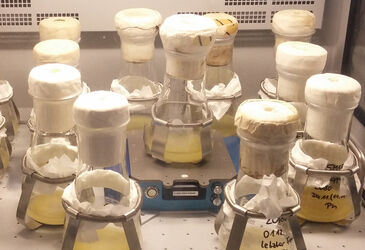Watch tutorials, webinars and informative videos about PreSens optical sensor systems.
Optical Biomass Measurements in a Salvia fruticosa Cell Culture
Evaluation of the SFR vario for plant cell applications
P. Scherhag1, G. T. John2, C. Haas3 and J.-U. Ackermann1
1University of Applied Sciences, Department of Biochemistry and Bioengineering, Dresden, Germany
2PreSens Precision Sensing GmbH, Regensburg, Germany
3Technical University, Institute fo Natural Materials Technology, Dresden, Germany
Suspension culture of plant cells is gaining importance in production of pharmaceutically active substances as it is independent from environmental influences. In order to establish industrial production processes especially monitoring biomass development over time is of great interest. As plant cells in suspension culture tend to aggregate it is difficult to monitor optical density (OD). In these experiments online biomass measurements - based on scattered light detection - with the SFR vario was tested. The gathered online data of sage (Salvia fruticosa) suspension culture were in good accordance with offline, gravimetrically measured biomass values. Furthermore, the SFR vario was used to perform online oxygen measurements, which gave additional information on the cultures' metabolic status.
The use of plant cells in industrial production processes requires that the product yield is increased. Therefore, and for successful scale-up detailed knowledge about culture performance and biomass development over time is required. As plant cells tend to form large aggregates in suspension culture the measurement of optical density OD is hardly applicable. In this study different online and offline biomass measurement methods were tested, in order to find a suitable monitoring routine for production processes with plant cell suspension cultures. The SFR vario device was developed for online O2, OUR, pH and biomass measurements inside shake flasks. Its biomass measurement principle is based on scattered light detection. Light emitted by the device optics is reflected by the cells inside the culture medium and detected with a photodiode. The SFR vario was used to monitor S. fruticosa cell suspension culture. These cells form a very fine culture, without generating aggregates larger than 2 mm. We compared the online biomass data measured with the SFR vario to offline determined cell dry weight and settled cell volume. As the SFR vario is a multi-parameter measurement system it was additionally used to monitor oxygen inside the plant cell suspension culture during a batch cultivation (12 days) to get further information about the metabolic status of the cells.
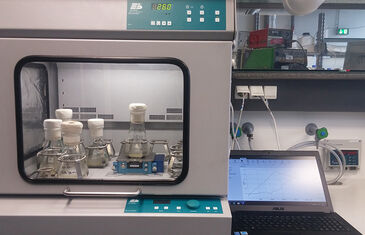
Materials & Methods
Suspension culture of sage (S. fruticosa) was performed in 250 mL glass shake flasks with a working volume of 50 mL. The culture was inoculated in liquid Linsmaier-Skoog medium with 30 g/L sucrose as carbon source and the phytohormone 2,4-dichlorphenoxyacetic acid. pH was set to 5.7 with NaOH. The inoculum was 20 % of the working volume. One cultivation was monitored online with the SFR vario (PreSens GmbH, Germany) to measure oxygen and biomass. In order not to disturb the online measurements several cultures were run in parallel and offline samples were taken from one separate Erlenmeyer flask each. The cells were cultured for 12 days in a darkened shaking incubator at 26 °C and 110 rpm. Online measurements with the SFR vario were taken at 30 min intervals. Cell dry weight and settled cell volume were determined in offline measurements as references. For settled cell volume measurements 10 - 15 mL culture from a sample shake flask were transferred into a scaled 15 mL tube and were set aside to sediment for 30 minutes. After the cells settled at the bottom of the tube the cell volume was read, given as percentage of the total volume. For determination of cell dry weight 15 mL culture were put on a dry and previously weighed filter (5 μm pore size, Sartorius AG, Germany) and vacuumed with Nalgene® DS0320-5045 (Thermo Fisher Scientific, USA). The filter cake was then washed twice with deionized water and dry frozen. After that it was gravimetrically weighed. Tests were performed as duplicates to enhance the accuracy.
On- and Offline Biomass Measurements in Plant Cell Suspension Cultures
The correlation of the online biomass signal and the offline determined cell dry weight gathered in two experiments shows a linear fit, as can be seen in Figure 2. Variations in the offline data were probably caused by slightly deviating growth in each shake flask and following variances in cell aggregation in each of the sampling cultures. The formula y = 0.1075 x + 0.12257 was used to calibrate the biomass signal amplitude measured with the SFR vario and convert it into cell dry weight concentration. In Figure 3 the calibrated online biomass values in g/L over time of two independent experiments is plotted together with the respective offline measurement values for cell dry weight and settled cell volume. All measurement methods show the same trend in biomass development. Online measurements show linear growth after a short exponential phase which is typical for plant cells in suspension culture. Furthermore, online measurements reveal different growth patterns of S. fruticosa in the two experiments with a longer exponential phase in experiment 2. These variations might also be caused by different starting cell densities, and therefore different aggregation of cells in each culture. This finding could not be derived from the offline data, and shows clearly the advantage of the online measurement system. In the online data of both experiments maximum biomass values were reached after about 200 h cultivation period. Offline data show different points of maximum biomass at 200 h for experiment 2 and 250 h for experiment 1. As mentioned before, samples for offline measurements were taken from separate cultures each, so not quite synchronized growth in the different shake flasks might have caused these variations.
The oxygen sensor spot integrated in the shake flask read with the SFR vario delivered a very good online signal, compared to the readings of amperometric sensors used to monitor plant cell culture in bioreactors, which have a very high noise ratio (data not shown). The online oxygen measurements show a constant decrease in the oxygen level for the first 100 h of the cultivation period and stay at a minimmum of about 50 % O2-saturation during the growth phase, indicating high metabolic activity of the cells. The slight fluctuations might indicate metabolic processess of the plant cells during their linear growth phase that have not been investigated so far. After the maximum biomass was reached metabolic activity of the cells stopped and the oxygen saturation level in the culture medium started to increase again.
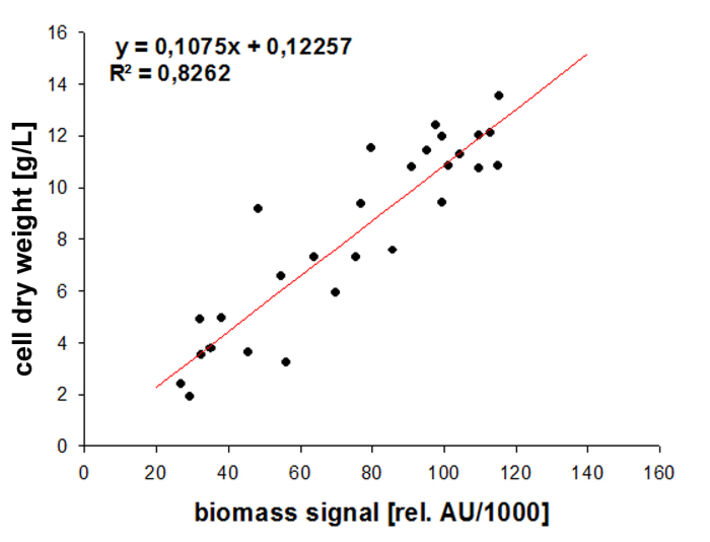
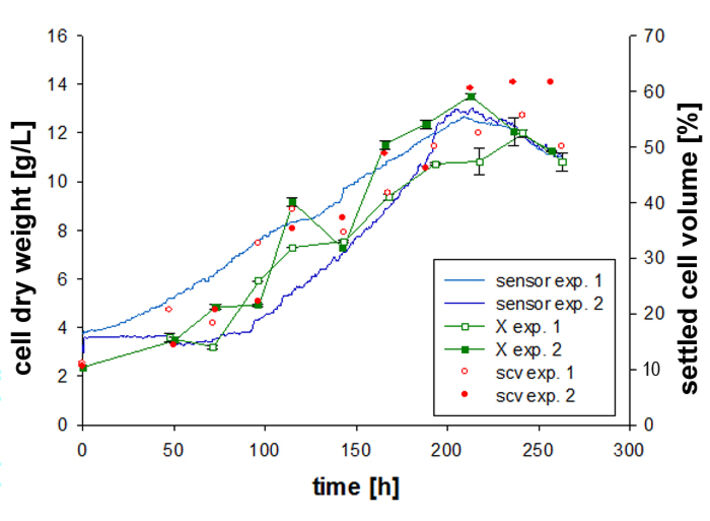
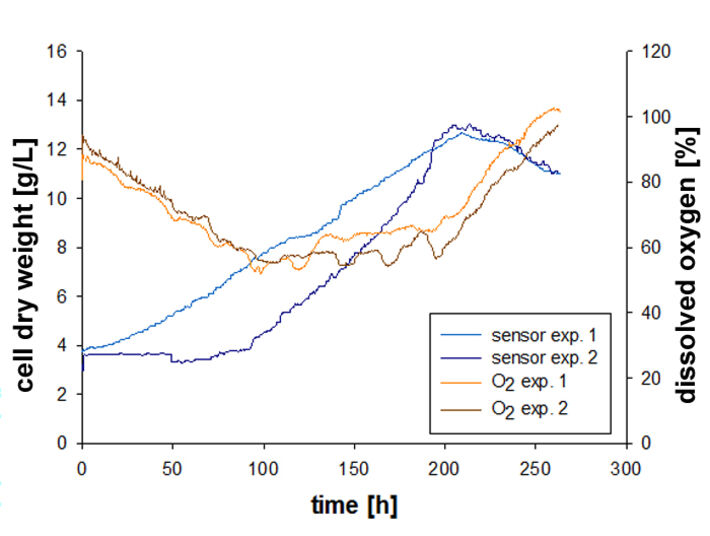
Conclusion
The applicability of online measurements with the SFR vario for plant cell suspension culture monitoring was proven with a S. fruticosa cell suspension culture. The online data are consistent with gravimetrically determined offline values, while giving a more detailed view of culture performance compared to the single-spot offline measurements. Combined with online oxygen monitoring valuable information about the metabolic behavior of the cultures could be gained. More tests with other plant cell lines forming larger aggregates are planned, to further evaluate online biomass monitoring with the SFR vario in plant cell culture.

